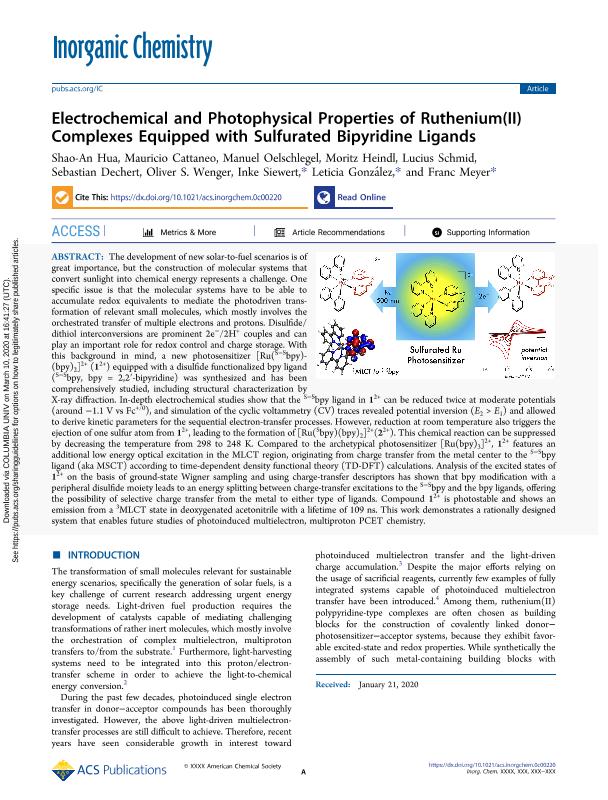Artículo
Electrochemical and Photophysical Properties of Ruthenium(II) Complexes Equipped with Sulfurated Bipyridine Ligands
Hua, Shao-An; Cattaneo, Mauricio ; Oelschlegel, Manuel; Heindl, Moritz; Schmid, Lucius; Dechert, Sebastian; Wenger, Oliver S.; Siewert, Inke; González, Leticia; Meyer, Franc
; Oelschlegel, Manuel; Heindl, Moritz; Schmid, Lucius; Dechert, Sebastian; Wenger, Oliver S.; Siewert, Inke; González, Leticia; Meyer, Franc
 ; Oelschlegel, Manuel; Heindl, Moritz; Schmid, Lucius; Dechert, Sebastian; Wenger, Oliver S.; Siewert, Inke; González, Leticia; Meyer, Franc
; Oelschlegel, Manuel; Heindl, Moritz; Schmid, Lucius; Dechert, Sebastian; Wenger, Oliver S.; Siewert, Inke; González, Leticia; Meyer, Franc
Fecha de publicación:
03/2020
Editorial:
American Chemical Society
Revista:
Inorganic Chemistry
ISSN:
0020-1669
Idioma:
Inglés
Tipo de recurso:
Artículo publicado
Clasificación temática:
Resumen
The development of new solar-to-fuel scenarios is of great importance, but the construction of molecular systems that convert sunlight into chemical energy represents a challenge. One specific issue is that the molecular systems have to be able to accumulate redox equivalents to mediate the photodriven transformation of relevant small molecules, which mostly involves the orchestrated transfer of multiple electrons and protons. Disulfide/dithiol interconversions are prominent 2e-/2H+ couples and can play an important role for redox control and charge storage. With this background in mind, a new photosensitizer [Ru(S-Sbpy)(bpy)2]2+ (12+) equipped with a disulfide functionalized bpy ligand (S-Sbpy, bpy = 2,2′-bipyridine) was synthesized and has been comprehensively studied, including structural characterization by X-ray diffraction. In-depth electrochemical studies show that the S-Sbpy ligand in 12+ can be reduced twice at moderate potentials (around-1.1 V vs Fc+/0), and simulation of the cyclic voltammetry (CV) traces revealed potential inversion (E2 > E1) and allowed to derive kinetic parameters for the sequential electron-transfer processes. However, reduction at room temperature also triggers the ejection of one sulfur atom from 12+, leading to the formation of [Ru(Sbpy)(bpy)2]2+(22+). This chemical reaction can be suppressed by decreasing the temperature from 298 to 248 K. Compared to the archetypical photosensitizer [Ru(bpy)3]2+, 12+ features an additional low energy optical excitation in the MLCT region, originating from charge transfer from the metal center to the S-Sbpy ligand (aka MSCT) according to time-dependent density functional theory (TD-DFT) calculations. Analysis of the excited states of 12+ on the basis of ground-state Wigner sampling and using charge-transfer descriptors has shown that bpy modification with a peripheral disulfide moiety leads to an energy splitting between charge-transfer excitations to the S-Sbpy and the bpy ligands, offering the possibility of selective charge transfer from the metal to either type of ligands. Compound 12+ is photostable and shows an emission from a 3MLCT state in deoxygenated acetonitrile with a lifetime of 109 ns. This work demonstrates a rationally designed system that enables future studies of photoinduced multielectron, multiproton PCET chemistry.
Palabras clave:
ruthenium complexes
,
disulfide
,
electrochemistry
,
multiredox
Archivos asociados
Licencia
Identificadores
Colecciones
Articulos(INQUINOA)
Articulos de INST.DE QUIMICA DEL NOROESTE
Articulos de INST.DE QUIMICA DEL NOROESTE
Citación
Hua, Shao-An; Cattaneo, Mauricio; Oelschlegel, Manuel; Heindl, Moritz; Schmid, Lucius; et al.; Electrochemical and Photophysical Properties of Ruthenium(II) Complexes Equipped with Sulfurated Bipyridine Ligands; American Chemical Society; Inorganic Chemistry; 59; 7; 3-2020; 4972-4984
Compartir
Altmétricas



